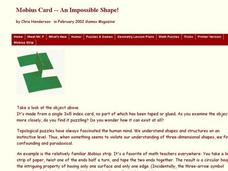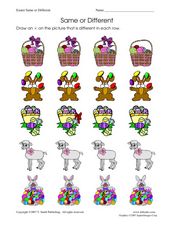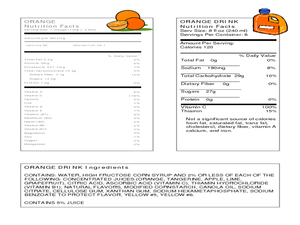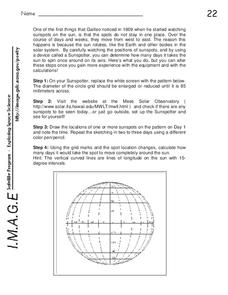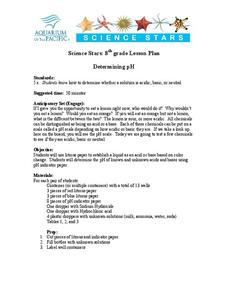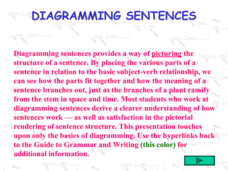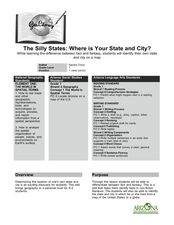Curated OER
Looking and Learning in the Art Museum - Lesson 1
Explore the artistic elements in artworks with an original and reproduction instructional activity. As learners recognize the difference between an original and a reproduction, they discuss the artist elements used in the...
Curated OER
Weather / Seasons
Third graders hear and use the terms: el verano, la primavera, el invierno y el oto¿¿o. They review particular months in Spanish. Students explore the difference in connections between months and seasons in northern and southern...
Curated OER
Deer: Predation or Starvation
In this balance of nature learning exercise, students use a data chart to graph wolf and deer populations over a ten-year period. Students use this graph to complete 3 short answer questions.
Curated OER
Can You See the Light?
Students investigate the transmission of light energy. In this light energy lesson, students observe bubbles using different colored filters and record their observations. They also look at a light source through various materials and...
Curated OER
Mobius Card- An Impossible shape
In this algebra worksheet, learners solve word problems using linear equations and algebraic symbols. There is one problem with an answer key.
Curated OER
The Colors of Chemistry
Young scholars investigate the acidity and alkalinity of common household products in an experiment. They use red cabbage juice and litmus paper to show the difference between strong acids and bases as they work with vinegar, dish...
Curated OER
Factoring Trinomials
Students factor trinomials using specific factoring methods. In this algebra lesson, students factor equations using the difference of squares and foiling. They play a game to enhance their understanding of factoring.
T. Smith Publishing
Easter Same or Different
On this colorful Easter-themed handout, little ones look at each row and determine which of the four pictures in each is different from the other three. Then they mark it out with an X. Refine observation and comparison skills with this...
Curated OER
Mapping the Census
Students learn why the census makes a difference. In this U.S. Census lesson plan, students learn the key elements of cartography, examine the difference between data and their representation, and create a map using census data.
Curated OER
Healthy Food is Good Food!
Students examine the difference between whole foods and junk foods. In this food lesson, students learn the definitions of whole food and junk food. They find the difference in tastes and textures of different foods by performing taste...
Curated OER
Horns or Antlers-You Decide!
Young scholars study the difference between horns and antlers. They identify animals who have each and draw pictures of these animals. They experience samples of actual horns and antlers.
Curated OER
Sunspots and the Sun's Rotation
In this sun worksheet, students use a Sunspotter to observe the rotation of the sun by identifying the presence of sunspots and watching them rotate over time. Students calculate how many days it takes to see the sunspots they observe in...
Curated OER
Digging Up Dinosaurs
In this report writing learning exercise, students prepare to write a dinosaur report by selecting and reading a nonfiction book. Students choose one dinosaur and write a report following the specific guidelines on this page.
Curated OER
Chapter 3 Worksheet Matter
In this matter learning exercise, students answer ten questions about matter including the phase of matter, mixtures and how they are different from compounds, the physical and chemical properties of matter and the difference between...
Curated OER
Determining pH
Eighth graders explain the difference between acids, bases and neutral solutions. In this chemistry lesson, 8th graders describe the properties of each. They determine the pH of an unknown solution using the indicator paper and pH scale.
Curated OER
Sunshine Math-2
In this problem solving instructional activity, students complete 8 varied word problems. Included are money, addition and subtraction, counting and fractions.
Curated OER
A Bug's Life: Diary of an Insect's Metamorphosis
Fifth graders examine the stages of insect's to understand heredity. In this inherited traits lesson, 5th graders explore the life of the honeybee for its inherited traits. Students recognize the difference between inherited traits...
Curated OER
Area and Perimeter of Rectangles
Discover the difference between area and perimeter. Learners are grouped in twos and threes and each group has one advanced/gifted learner to serve as the peer helper. They receive manipulatives to help them determine the area and...
Curated OER
Family Pedigrees
Students work as a class to first construct a pedigree of a popular singer, showcasing the singing gene being passed down through the generations. Students then make their own family pedigree and follow two traits through their family...
Tech Coach Corner
Diagramming Sentences
Show this presentation to demonstrate how to diagram sentences. Meant for more advanced grammarians who know the difference between indirect and direct objects, this PowerPoint adds on new elements to each slide. The graphics and sound...
Curated OER
Rectangles and Squares
Young scholars identify two dimensional shapes in the school environment. In this basic shapes lesson, students watch a video about rectangles and squares. Young scholars find examples shapes in their classroom and draw them. Students...
Curated OER
It's Hot
Third graders examine the effect of sunlight on the earth. Individually, they pick an article of clothing out of a bag and sort themselves based on the color of the shirt and whether it should be worn on a cold or a hot day. To end the...
Curated OER
A Pumpkin Surprise: Connect-the-Dots Game
In this math worksheet, students count from 1 to 50 as they connect the dots in a Halloween picture of a cat and Jack O'Lantern. Students color their picture.
Curated OER
The Silly States: Where Is Your State and City?
First graders read The Scrambled States of America and discuss whether it is real or fantasy as compared to the United States. In this geography lesson, 1st graders identify their city or state on a map and work in groups to color the...






